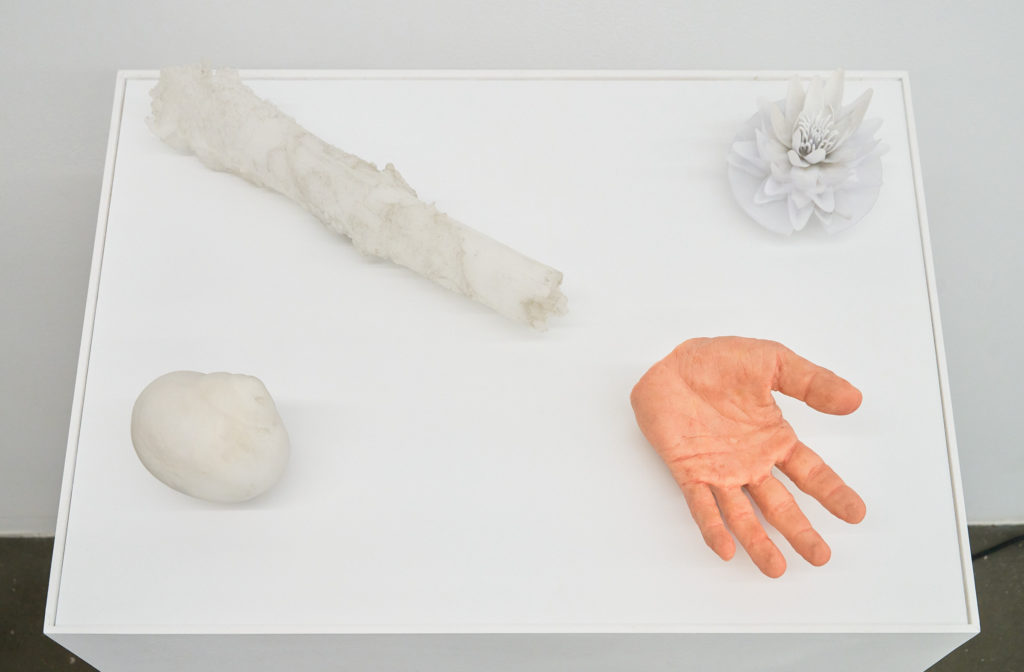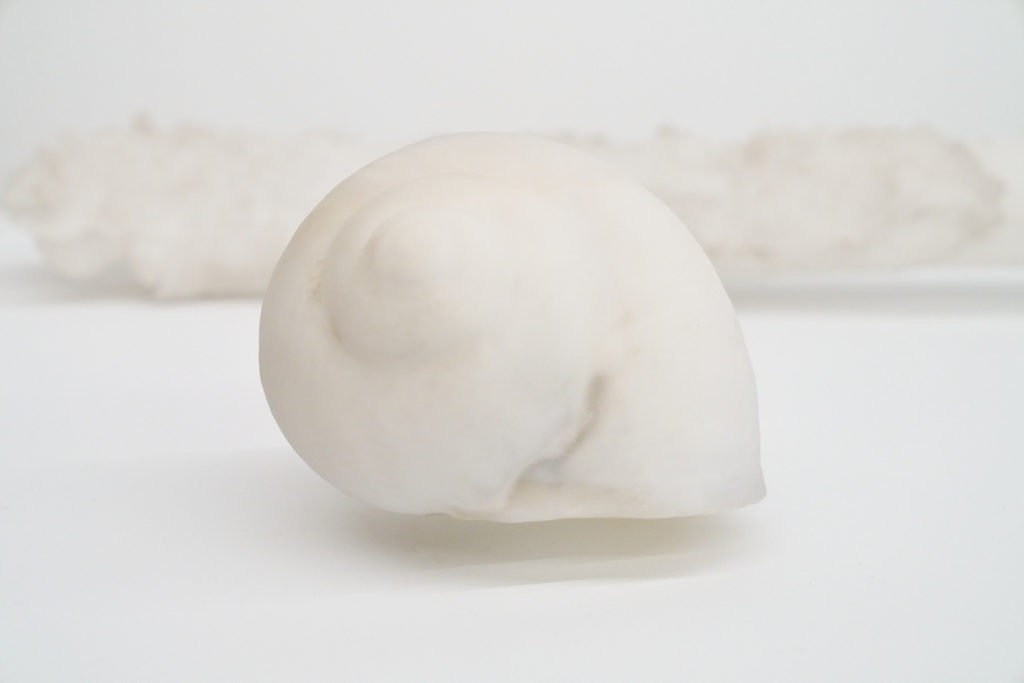Download Education and Accessibility Materials for To Carry the Earth
[descriptions of underlined words are provided in the Reference section]
Cuchifritos Gallery + Project Space is pleased to present artist Casey Tang’s new exhibition, To Carry the Earth, a spatialized audio and sculptural installation that investigates the limitations of dominant Western dialectical logic and egocentric spatial frames of reference (FoR).
Drawing from the artist’s extensive research into the history of systems science and psycholinguistic spatial frames of reference, the site-specific project speaks to the ways individuals, communities, and cultures make sense of the multiscalar processes underlying the phenomena we experience.
The conceptual framework of the installation is inspired by the artist’s experience of designing large-scale agroforestry and sociotechnical systems, which present a biosemiotic network relationality nested in an absolute FoR. This revised system accommodates a multiscalar, predicate-value logic, largely absent in egocentric frameworks, as a proposition to root humans with our senses in consensual coordinates tethered to place.
Tang’s sculpture, Here we are, hanging out in a Patritus, Bruno, Gassendi, or Newtonian Void, explores the lineage of Western thought structures, which rely heavily on a logic that often overlooks the importance of our senses and the contextual information that is crucial for situational awareness. The sculpture is comprised of 3D printed and silicon recreations of natural objects—snail shell, lotus flower, log growing lichen, human hand—hovering in mid-air, alluding to the Enlightenment-era emphasis on rational thought, disconnected from embodied experiences and the physical world. As with the audio installation, the levitating objects investigate Western knowledge systems’ lack of groundedness in the physical, Earthly realm.
“The uncanny hand anchors the concept of disembodiment, while the 3D objects’ surfaces and textures are reminiscent of ghost flowers (monotropa uniflora). Under the shade of tree canopies, a ghost flower grows on the dark forest floor. The parasitic flower, glowing bone white, does not generate food from sunlight like other plants, green from chlorophyll. Instead, the ghost flower utilizes an underground mycelium network to extract nutrients from its photosynthesizing tree hosts without giving back to them. In a monologue, the flower does not incorporate its enveloping environment into its logic or computation. Like us, it only needs a suitable network to access a host or, in our case, resources to survive. In deep shade, ghost flowers face down, only growing away from the sun.”
“This detachment from contextual grounding creates a sense of abstraction, placing knowledge, discussions, and our senses in an undefined abstract void or space. Indo-European languages, with their subject-predicate structure, reinforce this tendency by placing emphasis on the subject while neglecting the significance of the predicate. Additionally, Western epistemologies’ foundation on Boolean logic, notably exemplified in Shannon’s information theory that underlies our modern communication systems, has prioritized efficient information transmission while undervaluing meaning and context.
“When I speak, I rely on the English subject and predicate to make a daily prayer to relative and intrinsic separation. This grammatical structure was first conjured centuries ago by the Peripatetic school using Aristotelian logic. Today, when I intake phenomena and push air through my mouth to crudely fit what I sense into the same old syntax and metaphors, I reflow the past into the present, sending a constant perturbation in our meaning systems. When enough of us do this, we aggregate these values into our Reality–amplifying the boundary conditions of things and beings while placing everything in a Patritus, Bruno, Gassendi, or Newtonian infinite three-dimensional void.
“Life is characterized by complex adaptive systems recursively interconnecting outwardly and internally to maintain autopoiesis, communicate, navigate, learn, and adapt. In a critique of arborescent knowledge topology for its linear and hierarchical structures, like the phylogenetic tree and database structures, Deleuze and Guattari, influenced by Gregory Bateson’s biocybernetics, praised the rhizome and its many deterritorialized lines of flight, but the rhizome, once thought emancipatory, is now commonplace in our networked culture. It surges through all parts of our lives, separating and moving us along from app services and bureaucratic state systems to planetary-scale infrastructures. It even leads some to drive into rivers and deserts towards their untimely GPS deaths.
“Ecological gardens, and the ecosystems they mimic, are a bridge from our semiotic world to the logic and attitude of atmosphere, the recursive processes of evolution, the interdependent organization of multi-species, and the rhythms of metastability in non-equilibrium dynamics within a world of complexity. Living beings at this scale resonate with our most fundamental being—within the evolutionarily older parts of ourselves—still unconsciously tied to the ebbs and flows of nature or persistent ancient networks of relations. These are the cells that constitute our bodies and, with our medulla oblongata, are responsible for unconscious processing. They regulate our lungs easily and without self-reflection, allowing us to continuously breathe oxygen from Earth’s atmosphere and expel carbon dioxide to be taken up by our symbionts, the vegetal beings.
“Algorithms and AI unleashed by their corporate creators meet and influence us as we navigate, obtain, and send information on the Internet. Their systems enable and amplify selected agents’ behavior. Under the mimicry of infinite selections, our degrees of freedom are limited to sets favored by the companies and the employees who create them. These technical systems have grown to a planetary scale, and their emergent structures have strong downward causation: the semiotic, cognitive, social, biotic, and abiotic are entangled. They are increasing their interoperation and signal speed, aggregating towards the speed of thought. Corporate algorithms are superseding human agency and creating partitioned echo chambers. Platforms with Internet network dominance choose to amplify emotional content—often extremist views and propaganda—in exchange for engagement, behavioral and personal data, influence, and money. Leading to frequent global disruption faster than we can comprehend and respond collectively.
“An ecosystem or any phenomenon viewed from an egocentric perspective is more personal, experiential, and localized. No matter what relational metaphor is theorized and ‘understood’ or ‘kept in mind’. We will always default to embodying a nodal being within a network floating in a void. If we step out of the network enclosure into one with more degrees of freedom, we will be assisted with the absolute frames of reference, a fixed, external point of reference based on sociocultural importance, e.g., cardinal direction, cosmology, etc. If we enlarge our de facto coordination system and spatial thinking from the relative and egocentric to the absolute and planetary-scale geocentric, we can move from sensing as nodes in a network to carrying the Earth everywhere we go. An absolute FoR roots us and our senses in consensual coordinates tether to place.”
– Casey Tang
Read Casey Tang’s exhibition essay “To Expect Worlds, Carry the Earth”














Reference
Agroforestry
The intentional integration of trees and shrubs into crop and animal farming systems to create environmental, economic, and social benefits.
Sociotechnical systems
A sociotechnical system is an approach to complex organizational design that recognizes the interaction between people, organizations, and technology.
Biosemiotics
Study of signs and meaning in living organisms and systems. Tang’s exhibition further explores the ways living organisms and systems orientate themselves and how they make meaning of their environment, as an alternative to how most Western societies follow a predominantly egocentric frame of reference.
Autopoietic
The term autopoiesis describes the capacity of living cells to reproduce and organize themselves. Another way to understand the term is that it denotes the ability to self-create.
Biocybernetics
Biocybernetics is the application of cybernetics to biological science disciplines such as neurology and multicellular systems. Biocybernetics plays a major role in systems biology, seeking to integrate different levels of information to understand how biological systems function.
Semiotics
The study of signs and symbols and their use or interpretation within meaning-making. Tang’s exhibition explores alternative processes and references we use to make sense of the world around us.
Medulla oblongata
The connection between the brainstem and the spinal cord that carries multiple important functional centers.
Cardinal direction
The four cardinal directions, or cardinal points, are the four main compass directions: north, south, east, and west. Relative to the north, the directions east, south, and west are at 90-degree intervals in the clockwise direction.
Geocentric
Geocentric spatial frames of reference are a way of describing and understanding spatial relationships in language and cognition using Earth’s coordinate system as reference points. Geocentric frames allow us to communicate and perceive spatial information based on a community’s agreed-upon fixed axis rather than our perspective or the position of objects.
Project support has been provided by Harvest Works, Tom Poulton (Lecturer in Linguistics, School of Humanities and Social Sciences, Department of Languages and Cultures, La Trobe University), Shisanwu LLC, and Chris Ick.
Casey Tang is an artist and researcher focused on the interrelation between linearity, recursion, agency, organization, and self-organization within large social-technical-ecological systems. Casey graduated from the Massachusetts Institute of Technology (MIT) with a Master of Science in Art, Culture and Technology. He is a recipient of the 2021 Digital Diasporas Research Fellowship at Chronus Art Center, 2018 Center for Contemporary Art Kitakyushu Fellowship, 2015 Queens Museum/Jerome Foundation Fellowship for Emerging Artists, and 2013 New Vision Award from He Xiangning Art Museum.
He has exhibited in the US, Europe, and Asia. Including “Catalyst” at the Queens Museum, “CAFAM Future: Observer-Creator” at the Central Academy of Fine Art Museum, Beijing,and “LANDMARK” at Socrates Sculpture Park, a solo exhibition at Charpa Gallery, Spain, book project, First Sounds with Booklyn. His work is in various collections, including Stanford University, the Inelcom foundation, and the He Xiangning museum.
Cuchifritos Gallery + Project Space is located inside Essex Market, which is fully accessible by ADA standards. The gallery can be accessed from any ground floor entrance. Cuchifritos Gallery welcomes assistance dogs and has wheelchair-accessible restroom facilities on the lower level and 2nd floor, which can be accessed by the east-side elevator. For access inquiries, please contact Artists Alliance at info@artistsallianceinc.org or (2×12) 420-9202.
Artists Alliance Inc.is a 501c3 not-for-profit organization located on the Lower East Side of New York City within the Clemente Soto Vélez Cultural and Educational Center. Cuchifritos Gallery is supported in part by the New York City Department of Cultural Affairs in partnership with the City Council. Exhibition programming is made possible by public funds from the New York State Council on the Arts with the support of the Office of the Governor and the New York State Legislature, and the National Endowment for the Arts. We thank the New York City Economic Development Corporation and individual supporters of Artists Alliance Inc for their continued support. Special thanks go to our team of dedicated volunteers and interns, without whom this program would not be possible.
